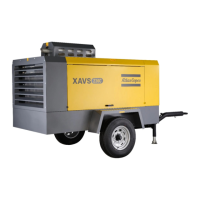- 32 -
DURING OPERATION
Regularly carry out following checks:
1. That the regulating valve (RV) is correctly
adjusted, i.e. starts decreasing the engine speed
when reaching the preset working pressure in the
receiver.
2. Check the air filter vacuum indicator (VI). If the
yellow piston reaches the red marked service
range, replace the filter element. Reset the
indicator by pushing the reset button.
Fault situations and protective devices:
A fault which occurs with the engine, either oil
pressure (too low), coolant temperature (too high),
will always and immediately cause the engine to cut
out and the alarm lamp H1 will light up.
By doing some simple checks, it can be determined
what it was that caused the engine to fail: low oil
level, clogged-up cooler.
Alarm lamp H2 will light up. The alarm lamp will
remain on, until the compressor has been restarted
(start switch to position 3), or the contact is turned off
(start switch to position 0; also when, due to cooling
off, the thermocontact has closed again (= memory
function).
STOPPING PROCEDURE
1. Close the air outlet valves (AOV).
2. Run unloaded for 3 minutes.
3. Turn the start switch S1 counterclockwise (CCW)
to position 0.
4. Push the circuit breaker button (F1) once (open
hood first).
When the engine is running, the air
outlet valves (ball valves) must always be
put in a fully opened or fully closed
position.
The hood must be closed during
operation and may be opened for short
periods only.
Do not open the air outlet valve when
machine is shut down. Remaining air
inside the vessel will be evacuated via a
blow down valve automatically!
If pressure is released from the vessel too
quickly, oil will start creating foam. This
foam could reach the oil separator
element resulting in oil carry over.
Failures caused by not correctly shutting
down the compressor will not be covered
by warranty!

